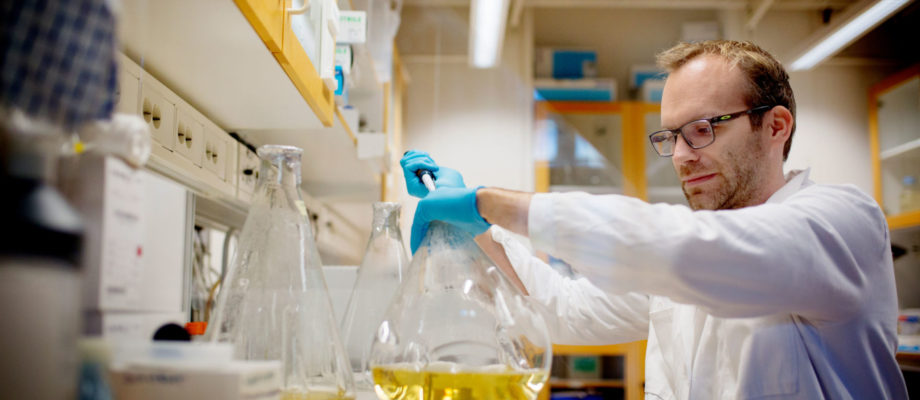YOUNG RESERACHERS. He is a top, young researcher, the recipient of several research distinctions in his field, who has come to Sweden and the University of Gothenburg through the Wallenberg Academy Fellows programme. But there is nothing particularly cocky about him. “I am very fortunate,” says structural biologist Björn Burmann, who is one of the group leaders within Wallenberg Centre for Molecular and Translational Medicine.
He conducts research on the structure and function of proteins, right down to the atomic level. By understanding how the processes work in great detail, it’s also possible to draw conclusions about what has happened when the processes don’t work. Examples of such malfunctions are illnesses such as Alzheimer’s, Parkinson’s and various forms of cancer.
“It’s extremely important to understand how the processes work if we are to find the root causes of why they sometimes go awry,” Björn Burmann says. “In this way, a future discovery might lead to finding ways to prevent these illnesses.”
IN RECENT YEARS THE Knut and Alice Wallenberg Foundation has given successful young researchers resources to enable them to concentrate on their research through the Wallenberg Academy Fellows programme. Some of the researchers have worked in Sweden, while others have been actively recruited from abroad. Björn Burmann belongs to the latter group. He was working at the University of Basel when he received the prestigious research grant in December 2016, one of two international researchers who moved their operations to the University of Gothenburg.
“We cannot stress enough the importance of these additions, who are now getting good opportunities to further develop their already successful research in good research environments with us,” Staffan Edén, deputy vice-chancellor of research at the University of Gothenburg, said in connection with the appointment.
 TO STUDY PROTEIN structures, Björn Burmann uses nuclear magnetic resonance (NMR) technology, an analytical method that requires sophisticated equipment. That was also how he came in contact with the University of Gothenburg the first time. There are a limited number of facilities for NMR spectroscopy in Europe, and the waiting period to use them is often long. Therefore, he contacted the Swedish NMR Centre in Gothenburg, a national research infrastructure that is part of the University of Gothenburg. When he then came here and conducted his experiment, researchers here encouraged him to apply for the research programme. He has now been working at the University of Gothenburg since 1 March.
TO STUDY PROTEIN structures, Björn Burmann uses nuclear magnetic resonance (NMR) technology, an analytical method that requires sophisticated equipment. That was also how he came in contact with the University of Gothenburg the first time. There are a limited number of facilities for NMR spectroscopy in Europe, and the waiting period to use them is often long. Therefore, he contacted the Swedish NMR Centre in Gothenburg, a national research infrastructure that is part of the University of Gothenburg. When he then came here and conducted his experiment, researchers here encouraged him to apply for the research programme. He has now been working at the University of Gothenburg since 1 March.
“It’s great to be here in Gothenburg, and the whole family like it here,” he says.
Part of his research concerns the repair mechanisms of cells and what is known as transcription-coupled repair. For the human body to produce enough vitamin D, people need to spend time in sunshine. But at the same time, the sun’s ultraviolet rays cause harmful chemical changes in our DNA. To protect against this damage, the cells have developed special machinery that can repair the DNA. The three researchers who made the first discoveries of the DNA repair mechanisms were awarded the Nobel Prize in chemistry in 2015, and Björn Burmann now wants to delve deeper and explore how the proteins work and how they communicate with each other. In the past, researchers have demonstrated that a protein called MfD plays a significant role in DNA repair, but Björn Burmann will now explore the functions of two other proteins.
“In recent years discoveries have indicated that there are other systems that play a greater role than was previously known.”
THERE ARE SEVERAL methods for studying protein structures, and NMR spectroscopy is one of them. The advantage of this method, Björn maintains, is that you can look at many different things in the same sample. Even if the structure of a protein does not change when the protein has a mutation, it’s possible with NMR technology to see that the signal has been changed so that the protein no longer functions properly.“One of the strengths of using NMR technology is that we can ask ourselves the question: How does the mutation affect the protein even if it does not change the structure?”
Björn Burmann has always had a great interest in the natural sciences and how things work, but it was not until his late teens that he thought it might be cool to become a researcher. That he then went into biochemistry and afterwards structural biology was mostly a coincidence.
“It’s not that I wanted to become a researcher since I was five; it was more of a process,” he says with a smile.
NOW HE HAS BEGUN building up his own research group, and so far he has two doctoral students in place. He has many international contacts with researchers in related fields that complement his own research, and he hopes to collaborate more with researchers here in Gothenburg in the future. His dream is that his research findings will provide new insights.
“I don’t expect to be able to cure all the illnesses in the world with the help of my research, although of course that would be fantastic, but that it will offer new clues to how degenerative illnesses and various forms of cancer arise.”
TEXT: CAMILLA PERSSON
PHOTO: MALIN ARNESSON











